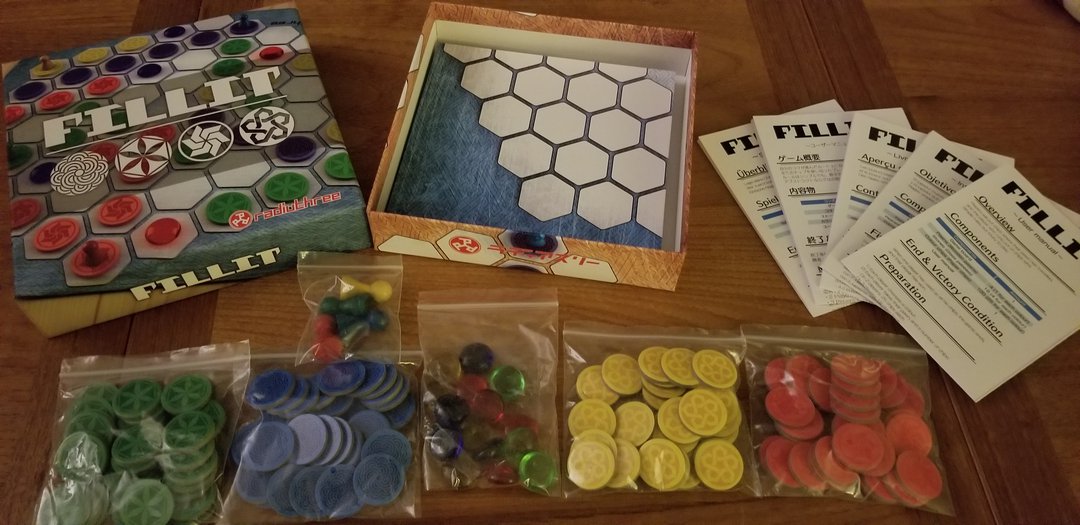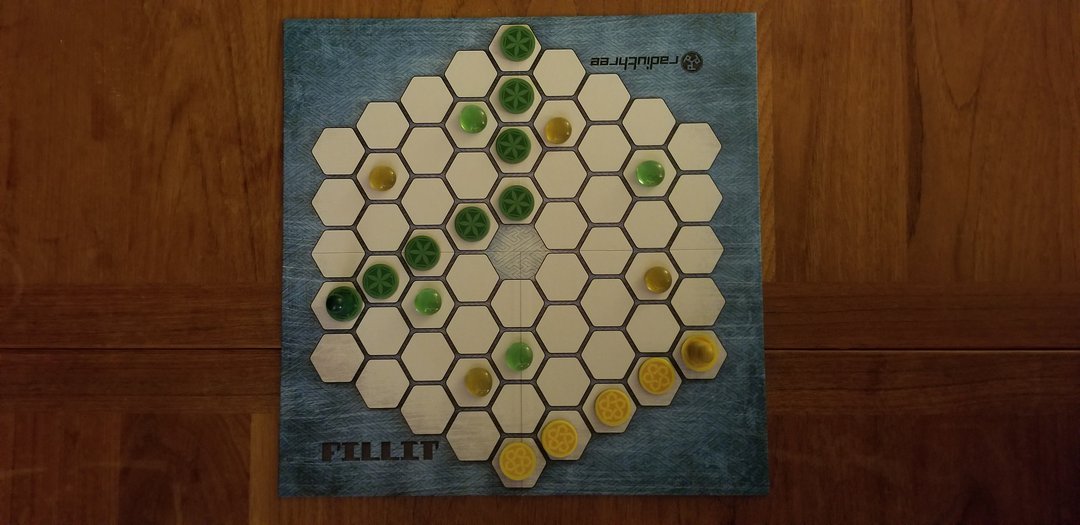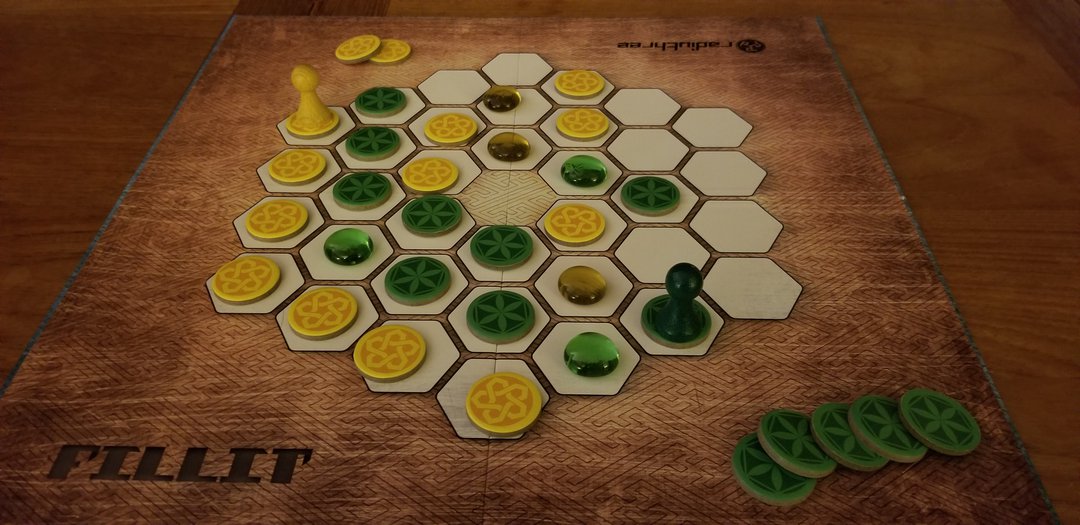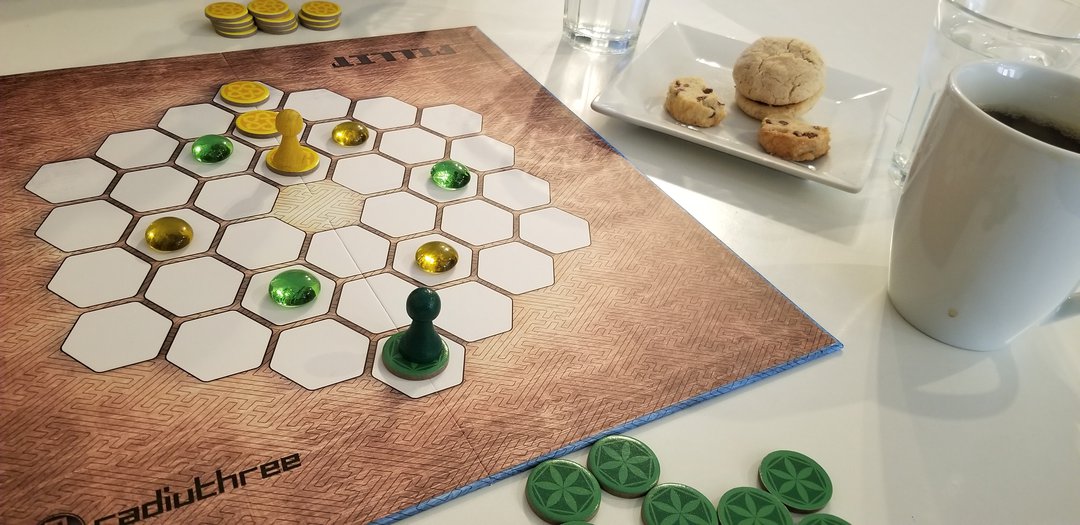FILLIT comes to us courtesy of Big Cat Games, a company dedicated to bringing board games from Japan to the wider world. If that name is familiar it's because I've written about them before, a couple times, and today I'm very pleased to be sharing a preview on a smart little abstract title currently on Kickstarter. FILLIT is a game so simple to learn that I'd read the entirety of the rules in the time it took my opponent to get a drink from the other room. I literally did a double take, flipping the single sheet of paper back and forth in my hand to make sure I hadn't missed something. And yet, FILLIT is deceptively devious in all the ways you'd expect of the best abstract strategy games.
Let's have a look!

Everything you get in the box. Please keep in mind this is a pre-production copy and things may be subject to change in the final release.
Clean And Crisp
I'm normally a little reticent to write previews for Kickstarter games. For one thing, they’re not full-on reviews as I don't get the same time luxury I'd prefer for the full treatment. For another, Kickstarter previews have a limited shelf life. You read them, you back the campaign (or you realize it's not for you), and you move on. For me to get excited previewing a game on Kickstarter for you, it's got to have that certain special something. FILLIT, I'm very pleased to say, does.
A game is played incredibly simply. On your turn you move both your pawn and one of your colored stones. The objective of the game is to play down all your colored tiles to the board, dropping them in a trail as your pawn moves, and winning as soon as your last tile drops. If you move across an opponent's tiles, you swap them for yours. When you move your pawn, it continues in a straight line in any of the six directions from its current hex, and it only stops when it hits an obstacle. That is, another pawn, a stone of any color, the middle hex of the board, or any of the board's edges. You can move either your pawn or a stone first, though you must give priority to moving your pawn if moving a stone first would leave it with no legal move. Stones move one space, by the way, and if they move into a space with anything, they swap places with it.
That might seem like a lot of rules I've just frontloaded you with, but basically that's it. Make some moves, drop some disks, use your stones to alter your moves (or those of your opponent), and win faster than the other person.

The large board side, two player game.
My first game was largely a series of happy blunders. Move a stone to unblock my intended path and march my pawn across as many spaces as possible. Move another stone the next turn to block what I thought might be my opponent's move only to discover it also opened up new avenues of movement for me as well. Maneuver into a position to follow my opponent's path from two turns ago, literally overlapping their prior pathways and flipping all their hard earned tiles to my color. It was interesting right from the first game, but if it was going to hold my interest it needed to offer more. The rabbit hole needed to get deeper with each game.
Thankfully it did. With each match the game offered up new tricks. Stones could be used like revolving doors to pull me around corners or obstacles after a move. That is, if I was willing to forgo a block on my opponent in favor of more mobility for myself. I could move on one side of the board while blocking another with my stones. If an opponent looked to be moving in on my hard earned tiles, I might pull a stone in front of them, slamming the door shut in the face of their advance. Similarly, I found myself on the end of clever blocks, cornered sometimes by the opponent's pawn itself! Matches were close, tense, and full of plays that made me want to say “Good move!” While the nature of the game prevented me from thinking too many moves ahead (something I actually don’t care for in games like Chess), I began thinking in chains of at least two or three moves, predicting my opponent’s likely reactions and choosing to attack or defend in a way I thought might best keep my options open. And even though there’s no greater theme bolted onto the game, I couldn’t shake the feeling of a Tron light cycle feel, or perhaps two wizards dueling.

The small board side, two players. This is my preferred setup, though both are great in their own rights.
Ways To Play
FILLIT comes with a double sided board for varied setups. The large map gives players the opportunity for some truly spectacular plays, sweeps of half a dozen tokens or more dropping at once if an opponent isn't careful to block the straightaways. There's room to maneuver and to set up strategies while catching your breath, yet it never lacks for interaction. Games on this map are naturally played with more tokens and colored stones. The smaller board, by comparison, is much more than a scaled down version of the game. Its character changes drastically, even though only a single stone and a handful of tokens have been cut away. Stone movements become even more tactical and tricky, giving the game a much tighter feel. If the large map is a battle of artillery, the small map is a knife fight. In terms of play time, both play in ten minutes or less for a two player game. They're both excellent in their own rights, though I think I personally prefer the smaller map for the tightness of moves and lack of big swings seen on the larger board.
The game, in addition to the two player setup, can be played three player or four player in teams of two. The three player setup offers perhaps the most chaotic of FILLIT’s game modes. It’s hard to shake the feeling of always fighting a 2v1, since there’s equal chance you’ll be attacked instead of the other opponent, along with a little bit of “bash the leader” syndrome. The four player setup is an interesting departure from the other modes, offering you a partner-based game not unlike War Chest or many classic trick taking games. This is a setup I could see being very chaotic, good for silly fun, when played casually with a bunch of friends, but if you have three other people willing to dive in with you, this style of play offers a lot of promise for serious groups. Heck, if you have a ton of interested people at game night I could even see organizing a doubles league.

The box is small enough for you to toss in a shoulder bag and take to a nice cafe.
Wrap Up
All in all, I think FILLIT shines as one of the best abstract strategy games I’ve played in recent days, always enticing me or my opponents back for “just one more game.” And thanks to its quick play time, we can play that one more, and then another, and then another. The rules can be taught in 30 seconds, but play takes several games to really come to grips with. The varied setups and board sizes offer a fair amount of replayability, along with all the different strategies you can employ. While I’m happy for the addition of the three and four player setups, I think FILLIT shines particularly well as a two-player game, and unless you’ve got a dedicated group to play doubles with (or you really like asymmetrical 3 player setups) I’d plan to play it at that count. Finally, I’d like to mention that as with most abstract strategy games that have no luck elements, the better player will always win here, so keep that in mind if you plan to use this game to introduce newer gamers to modern board games, or if you’re playing with players of widely disparate skill levels.
Whether as an easy-to-learn title for a newer gamer or a clever strategy import for the experienced gamer’s shelf, FILLIT is a brilliant addition to any board gamer’s library. Big Cat Games continues to select high quality designs to bring overseas, and I think they’ve knocked it out of the park again with this solid, simple title. You can find a trio of abstract games, including FILLIT, here on Kickstarter if you’d like to see more details about the campaign.